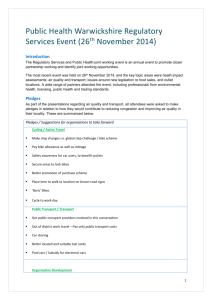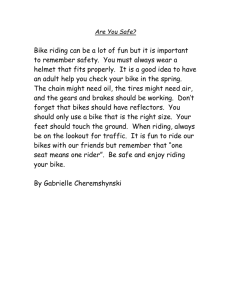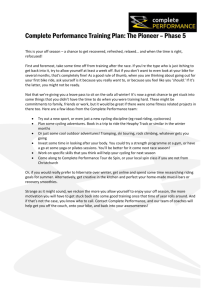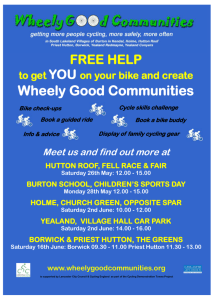bike local supporter’s guide
advertisement
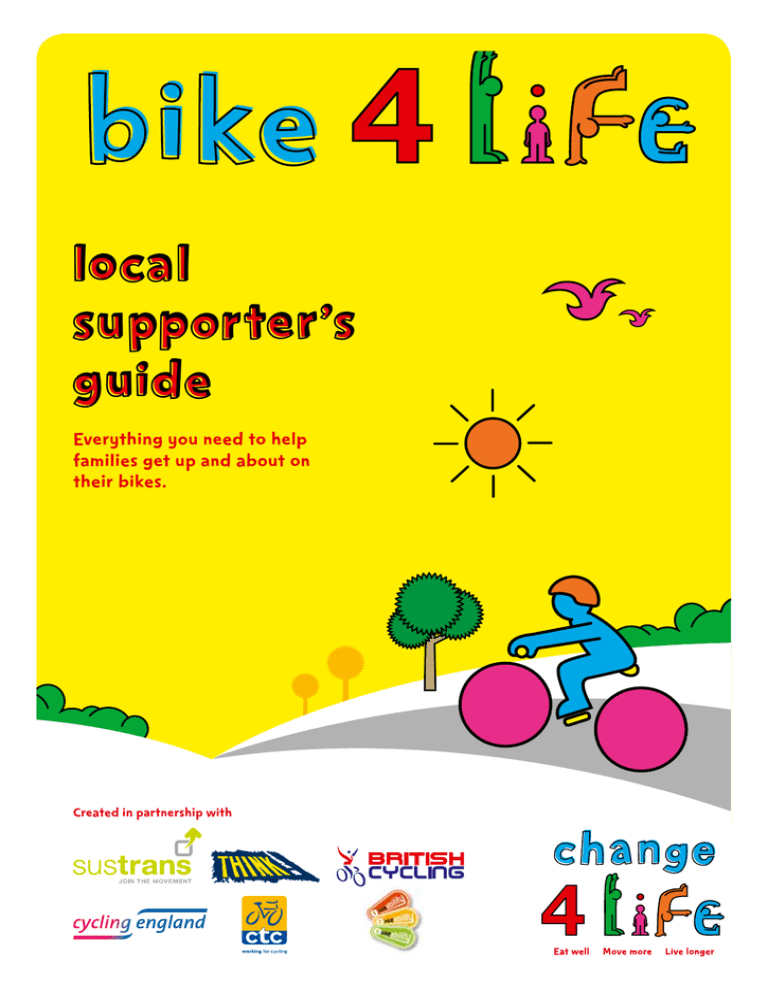
bike local supporter’s guide Everything you need to help families get up and about on their bikes. Created in partnership with 2 Welcome to BIKE4Life Bike4Life has been launched to support Change4Life, which aims to help us all live healthier, happier and longer lives. The Bike4Life Toolkit contains ideas to get families out on their bikes together. We want to tell parents and carers that cycling is a great way to exercise with their children and remind them how much fun it can be! They’ll be able to explore their local surroundings and discover new places, as well as benefit from being active in the fresh air. We also want families to know that cycling is good for their health. It counts towards the children’s 60 active minutes per day – recommended for 5-16 year olds – and can give everyone a good cardiovascular workout without putting stress on joints. By taking sensible steps, cycling can be safer than many people think. So there’s nothing stopping them from encouraging their family to ride, and getting back in the saddle themselves. e? if L 4 e g n a h C o t New ims to vement which a ide mo It’s the nationw ren, to eat well, d il h c y ll ia c e sp help everyone, e longer. Find out more by live move more and l Supporter’s ca o L e if L 4 e g n a reading the ‘Ch Guide’ here. 3 What’s BIKE4Life all about? An important part of Change4Life is keeping active and getting into the habit of moving around regularly. Cycling is a great way to help stay healthy and by cycling more often, whether it’s part of a routine or a way to go out and explore, families will be well on their way to achieving some of the changes necessary for a healthier future. Our research tells us that parents may find some of the lifestyle changes suggested by Change4Life harder to make than others. To address this, and with your support, we want to help parents, children, partners and supporters of the campaign to find simple ways for families to make these changes. Cycling can be a relatively easy activity, and once families have the right equipment, knowledge and encouragement, all it takes is a little bit of practice! Remember, the younger children start to ride, the easier it is to learn. 4 Small changes, big benefits Change4Life is all about making small lifestyle changes that add up to big health benefits. We’ve identified 8 healthy changes that families may consider making for a healthier future and cycling can help achieve two of them in particular. 60 active minutes ‘Active kids are happy kids’ – they like to be up and about, running around and having fun. The trouble is, there are lots of other distractions and plenty of reasons not to be active outside. Children need to do at least 60 minutes of physical activity every day that gets their heart beating faster than usual. This activity doesn’t have to be all in one go – it can be made up of 10 minute bursts which may be easier to fit in throughout the day. Being active will burn off energy and prevent excess fat being stored in the body. It also helps their muscles and bones grow to full strength. It’s important that families understand that not keeping active and a poor diet can lead to serious illnesses in later life such as cancer, type 2 diabetes and heart disease. Cycling is an easy and fun way to help families achieve their 60 active minutes. It’s a great way for them to spend time with their friends and family, discovering new places or as part of their regular travel. up & about Modern life has made things much more comfortable for us – so comfortable, in fact, that most of us spend too long in sedentary activity that doesn’t burn off the energy we are consuming. Of course it’s important to relax, but there’s a difference between chilling out and vegging out. The fact is that inactive children are at risk of storing excess fat in their bodies. The solution is simple – get families up and about! A family bike ride is a great way of making sure everyone is moving around and having fun – there are so many things to see and do along the way! Teaching children to ride a bike from an early age also gives them a skill for life and helps them become confident and more independent. ore about Want to read m hange4Life? the 8 ways to C e4Life Local Read the ‘Chang de’ here. Supporter’s Gui 5 How can you help families BIKE4Life? The best thing about cycling is that almost anyone can do it, anywhere, at any time. It’s fast, cheap and reliable and it helps to keep you fit. It’s also good for the environment as there are no CO2 emissions and the only energy that gets burned is by the person riding the bike! However, there are a few things that may prevent families from getting on their bikes. Here are some reasons families may give for not wanting to ride bikes – and some answers for you to use! “Bikes are too expensive” A good bike needn’t cost a fortune. Visit a selection of bike shops or use the internet to get a feel for what is available within your budget. There’s no need to buy a really expensive bike with lots of gadgets that you don’t need. But beware of bikes that are too cheap as they may not last. Look out for second-hand bikes too. If you see one you like, get someone who knows about bikes to go with you and check it out. You could end up with a bargain! And remember, by using a bike instead of other transport, you’ll also be saving money on travel costs. “I don’t know what sort of bikes to buy for me and my family” Your local bike shop can help you choose the right bikes, and the Change4Life ‘Getting and looking after you bike’ guide is full of helpful tips too. If you’re unsure about buying bikes, you could hire some for the day or the weekend. Then you can see how enjoyable it can be before deciding to buy your own. Just search for ‘bike hire’ online or get in contact with a local bike group. Your local authority may be able to help you find suitable groups, or try your local telephone directory. 6 “The roads are too dangerous for children” Some roads can be daunting for cyclists, but with the right training and practise, there’s no reason why confident children can’t ride on busier roads. There are also lots of cycle routes on less busy roads that are ideal for young riders. “I don’t feel confident on a bike” Start slowly by finding a quiet stretch of road or track away from traffic to practise on before setting off on your first journey. Consider some approved training for you and the children through Bikeability, the new name for cycling proficiency, at www.bikeability.org.uk “My children aren’t interested in cycling” It’s easy to make cycling a really fun activity by building in visits to places like play-areas or taking toys and games with you. For a real family adventure why not explore an imaginary dragon’s cave or some woodlands where the fairies might live. “We live in the middle of a busy town” Do a little research and you’ll be surprised how many pleasant cycling routes there are, even in the biggest and busiest places. Look in local parks and along the banks of rivers and canals flowing through the city. Visit the Sustrans website at www.sustrans.org.uk to find information on the National Cycle Network. You can also contact your local authority to find cycle routes where you live. There are many simple ways to encourage families to get out and have fun on their bikes. By working together and by using the facts and tips on the next few pages, we can help you to get families out on their bikes, enjoying themselves and getting fit, in a safe way! 7 Tips on buying and looking after a bike Buying a bike needn’t be difficult or costly There are all sorts of bikes available, from mountain bikes to road bikes and anything in between. The choice can be a little overwhelming, but a general rule is to choose one that suits the terrain where it will be used most often. Buying really cheap bikes for the family can be a false economy. Investing in a good bike means that it will last until it is outgrown, and can be passed on to younger brothers and sisters afterwards, saving money in the long run. Taking good care of a bike will keep maintenance costs down to a minimum, in particular keeping the chain oiled, tyres pumped up and regularly checking the brakes. You can provide parents with a range of tips on buying a bike and keeping it in good working order by downloading the ‘Getting and looking after your bike’ guide here. Second-hand bikes can be another good option There are lots of adverts in the local paper or shops, or on internet auction sites. As long as they check a bike thoroughly before buying, parents could end up with a bargain! Try before you buy Some families will not have access to bikes and it’s a big leap to purchase a bike if they’re not sure cycling is for them. So why not suggest the following alternatives: • Bike Try Out sessions – these are often run in local communities as part of cycling promotions at bike shows, festivals, bike shops and events during annual Bike Week in June. It’s worth looking up what is going on in your local area by getting in touch with your local authority or cycling organisations. • Bike hire – there are many fleets of bikes for hire, often at stations, country parks and national parks. The Forestry Commission and CTC in particular have a wide range of centres with bike fleets. Cycling for people with disabilities There are lots of bikes available to both children and adults with disabilities. The two main providers of specialist bikes are Wheels for All and CTC. For more details visit www.cycling.org.uk/wheels-for-all and www.ctc.org.uk retailer near To find a specialist cycling xperts.co.uk you, visit www.thecyclinge 8 Cycling safety tips As supporters of cycling, we need to build the confidence of parents and carers so they are happy to get their children up and about on bikes. Whether it’s playing with friends, enjoying a family bike ride or cycling to school, there are lots of things people can do to help children stay as safe as possible and be prepared for different situations. Get some training The best way to make sure children are fully prepared is for them to be trained by an approved instructor. Bikeability is the new name for Cycling Proficiency and gives children the skills, control and confidence they need to ride on today’s roads. Bikeability is delivered in schools through local authorities and Schools Sports Partnerships. It equips children with the skills they need to cycle on quieter roads and understand the relevant highway signs, making it a good way to provide parents and carers with added reassurance. Information on Bikeability courses in your local area can be found at www.bikeability.org.uk eability If you would like to run Bik to ride to help your children learn .org.uk safely, visit www.bikeability 9 Make sure the bike fits It’s really important to buy the right size of bike for a child. You might think a large bike will last them longer, but it will be heavy and could be uncomfortable to ride, and potentially unsafe. A child must be fully in control of their bike. They should be able to put both feet on the floor when they’re first starting to learn, and once they’re riding they should be able to get the ball of one foot on the ground when they are sitting on the saddle. Wear the right protective gear Helmets are a must and should be properly fitted. Long-sleeve tops and trousers also offer added protection, as do elbow and knee pads. Be safe, be seen Make sure other road users can see you by wearing light-coloured clothing. Better still, wear fluorescent clothing or bands in the daytime and reflective clothing at night. Fluorescent tops can also be printed over with fun designs which encourage children to use them! Care when carrying Even if only small items are carried they must be safely stowed away on a proper rack or in a small backpack away from the bike. Remember that when riding at night, a working white front light and red rear light and reflector are required by law. t cycling For more information abou download safely on the road, you can ide here. the ‘Tips for safer biking’ gu 10 Cycling is fun for all the family Most of us played on bikes as children. We want to remind families how much fun a family bike trip can be. Especially if they take in a play-park, funfair, beach or even the cinema. If the weather’s nice they could even take a picnic; if it isn’t, then a visit to a nice warm cafeé or family-friendly pub can be a well-earned treat. Don’t forget that even if your kids are too young to ride a bike they may be able to enjoy the outing in a child seat or bike child trailer. Advice and guidance on the correct seat or carrier and the age from which children are able to go in these should be obtained from cycle retailers. Where to go Half the fun of a bike-trip is deciding where to go. The internet is a great tool for planning trips and there are plenty of useful sites where families can find nearby cycle routes that suit their level of ability. When it comes to getting out on bikes as a family, it’s all about having fun. Encourage parents to start slowly and keep the first few trips short, because one mile can seem like five to tired little legs! If they are going on a long trip, make sure they plan lots of breaks. Sustrans is the UK’s leading sustainable transport charity, with lots of cycle routes around the country. www.sustrans.org.uk provides more information and local authorities may also provide cycle maps and information. Local cycle groups are a great place for families to meet fellow cyclists and new friends. There may also be bike groups in the area that children can join independently of their parents, allowing them to enjoy cycling in the safety of a larger group. British Cycling are introducing over 400 Led Rides in 2009 and more over the next 4 years to introduce beginners, recreational cyclists and family groups to cycling in traffic free areas and on the highway. More information can be found at www.britishcycling.org.uk for all the family, For more tips on cycling fun cycling’ guide here. download the ‘Fun ideas for 11 Group trips are great fun As a Change4Life local supporter, a good way to get everyone out on bikes and enjoying themselves is to organise a group trip. Here’s a quick guide to making it easy, practical and fun. 1. Pick a route that everyone will be able to finish comfortably. 2. Set a starting point that everyone knows, with local parking if needed. 3. Include some interesting places to visit on the way, especially for the children. 4. A scenic route makes the time pass so much quicker. 5. Get someone to help you organise and run the trip. 6. Do the trip with a colleague first so you know exactly what to expect. 7. Set a date well in advance so everyone has plenty of notice – 3 or 4 weeks is ideal. 8. Publicise the trip as widely as you can using posters, emails, announcements, and articles in newsletters and on websites. 9. Create a list of people who express an interest, making sure to get their email address and telephone number. 10. Create an email list from these names so you can send out a group reminder with one click! 11. Send out a reminder one week before the trip, and again the day before. 12. Include a list of what to take: water, healthy snacks, puncture repair kit, multi-tool and a pump are the bare minimum! Find other items they might need in our ‘Fun ideas for cycling’ guide here. 13. Get a colleague to lead the way while you stay at the back to make sure everyone gets around safely. Go at the pace of the slowest rider – then everyone’s going to enjoy the trip! 12 Cycling to School Cycling to school is a great way of keeping children and other family members active and healthy as part of their everyday routine, as well as being a free and fun way to get around. It is advisable for children to be trained to Bikeability standards before you decide to try cycling to school together. Both the transport and education departments of local authorities will have programmes to encourage sustainable school travel, including cycling, so it’s worth contacting them to find out what is available nearby. Schemes such as Bike it and Bike Club also offer help, and the Sustrans National Cycle Network also provides traffic-free routes throughout the UK, which can help people to plan their journeys. Bike scheme for employees Cyclescheme is the UK’s biggest provider of tax-free bikes for the Government’s Cycle to Work initiative. It’s a brilliant programme where everyone wins – employees make big savings on new bikes whilst employers get a healthier workforce and could save money too! The scheme allows savings of 30% to 40% on the retail cost of a bike and accessories! Visit www.cyclescheme.co.uk for more information. 13 Eat well, Move more, Live longer Medical evidence suggests that if we want to prevent fat building up in our bodies, we need to keep an eye on what we eat as well as how much energy we burn through activity. So when you talk to families about Bike4Life, it’s a good idea to remind them of the importance of eating healthily too. Don’t worry if your usual work or activities focus on cycling or keeping active and you don’t feel confident talking to parents about eating healthily. You don’t need to become an expert in a new subject. All we ask is that you tell families that both activity levels and diet are important, and signpost them to where they can find out more. A good place to suggest parents look is the Change4Life website at www.nhs.uk/change4life 14 Finding more information There are lots of Change4Life resources that you may find useful. They’re all available online, but some are also available as a printed pack for those who don’t have internet access. Making a Change4Life Change4Life encourages families to make 8 changes around diet and physical activity, for a healthier future. Read more about these changes, why they’re important and tips on helping parents make them, in the Change4Life Local Supporter’s Guide here. é Talking about Change4Life Our research shows that some ways of talking about the issues surrounding Change4Life are received better by parents than others. Get tips on how to explain things to parents, plus more ideas for ways you can support the campaign, in the Change4Life Local Supporter’s Guide here. éé The research behind Change4Life Read more about the research behind Change4Life in the Department of Health’s Consumer Insight Summary here. FREE Change4Life resources Lots of colourful resources are already available for you to use with families, including posters, leaflets and game sheets. Download them here. éé We are releasing more toolkits like this one to support different activities. Look out for Breakfast4Life, Walk4Life, Swim4Life, Play4Life and Dance4Life here. If you haven’t already done so, please register as a local supporter and we will tell you when new toolkits are available, plus you’ll get access to all the Change4Life logos to use on your own communications. The use of the Department of Health trademarks does not constitute or imply endorsement or recommendation by the Department of any product or service of the user. 15 Useful links and further resources www.bikeability.org.uk – find out more about the Bikeability training schemes in your local area. www.bikeweek.org.uk – the UK’s annual celebration of cycling with a large number of events aimed at promoting cycling. www.britishcycling.org.uk – as the nation’s governing body for cycling they have a comprehensive offering of news, services, advice and cycling opportunities for all levels. www.ctc.org.uk – the website of the UK’s National Cyclists’ Organisation has information on safety, local routes, activities, events, cycle training and more! www.cyclenation.org.uk – community groups encouraging cycling as part of daily life and working to improve conditions for cyclists. www.cyclescheme.co.uk – save money on a new bike through your employer. www.cyclingengland.co.uk – promoting the growth of cycling in England. Discover key cycling initiatives throughout England and access Bikeability training providers in your area. www.direct.gov.uk – search for ‘The Highway Code’ and find everything you need to know about staying safe on the road. www.britishcycling.org.uk/go-ride - the British Cycling Club’s development programme which supports the creation of school and cycling club links. www.sustrans.org.uk – find the closest cycle route to your home. Also see the ‘Links to Schools’ section for the new safer cycle routes that young people can use to cycle to school. www.talesoftheroad.direct.gov.uk – find out how children can stay safe on the road. It includes interactive games to help teach them road safety skills. www.thecyclingexperts.co.uk – find out about cycling specialists near you. Visit the CTC website to find out more about: • Bike Club – over 300 community cycling projects for young people and families. • CTC Community Development – a team who use lottery funding to provide access to cycling in local communities – an adult and family variant to Bike Club. • CTC Cycle Activity Provider Insurance – for scheme organisers and leaders. 16 Contact us The ‘partners & supporters’ area of the website has information, ideas and resources for local supporters including: • case studies • partner tools • FAQs • useful links Go to www.nhs.uk/change4life and click on ‘partners & supporters’. é Not online? Call the local supporter helpline on 0300 123 3434.* * Calls to 03 numbers should cost no more than geographic 01 or 02 calls, and may be part of inclusive minutes subject to your provider and your call package. We’re open from 9am to 8pm, 7 days a week.
